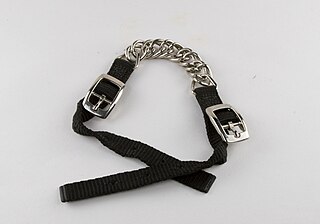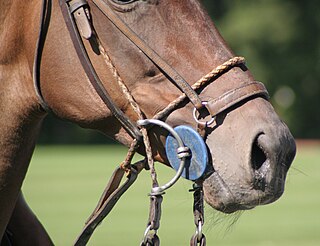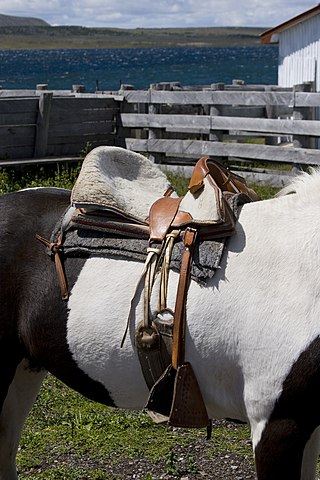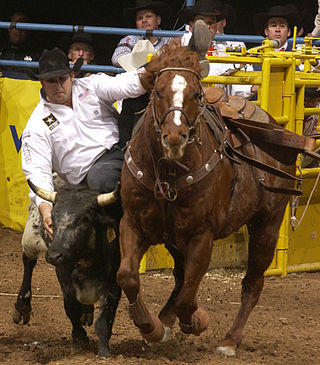Tack is equipment or accessories equipped on horses and other equines in the course of their use as domesticated animals. This equipment includes such items as saddles, stirrups, bridles, halters, reins, bits, and harnesses. Equipping a horse is often referred to as tacking up, and involves putting the tack equipment on the horse. A room to store such equipment, usually near or in a stable, is a tack room.

Equitation is the art or practice of horse riding or horsemanship.

A bridle is a piece of equipment used to direct a horse. As defined in the Oxford English Dictionary, the "bridle" includes both the headstall that holds a bit that goes in the mouth of a horse, and the reins that are attached to the bit.

The canter and gallop are variations on the fastest gait that can be performed by a horse or other equine. The canter is a controlled three-beat gait, while the gallop is a faster, four-beat variation of the same gait. It is a natural gait possessed by all horses, faster than most horses' trot, or ambling gaits. The gallop is the fastest gait of the horse, averaging about 40 to 48 kilometres per hour. The speed of the canter varies between 16 to 27 kilometres per hour depending on the length of the horse's stride. A variation of the canter, seen in western riding, is called a lope, and is generally quite slow, no more than 13–19 kilometres per hour (8–12 mph).

Longeing or lungeing is a technique for training and exercising horses. It is also a critical component of the sport of equestrian vaulting.

A surcingle is a strap made of leather or leather-like synthetic materials such as nylon or neoprene, sometimes with elastic, that fastens around the horse's girth.

A curb chain, or curb strap, is a piece of horse tack required for proper use on any type of curb bit. It is a flat linked chain or flat strap that runs under the chin groove of the horse, between the bit shank's purchase arms. It has a buckle or hook attachment and English designs have a "fly link" in the middle to hold a lip strap. On English bridles the horse is bridled with the curb chain undone on one side, then connected once on the horse. On western bridles, the curb chain is kept buckled to both sides of the bit.

A curb bit is a type of bit used for riding horses that uses lever action. It includes the pelham bit and the Weymouth curb along with the traditional "curb bit" used mainly by Western riders.

A double bridle, also called a full bridle or Weymouth bridle, is a bridle that has two bits and four reins. One bit is the bradoon, is a modified snaffle bit that is smaller in diameter and has smaller bit rings than a traditional snaffle, and it is adjusted so that it sits above and behind the other bit, a curb bit. Another term for this combination of curb and snaffle bit is a "bit and bradoon", where the word "bit" in this particular context refers to the curb.

The gag bit is a type of bit for a horse. Because the cheek piece and reins attach to different rings there is leverage action. Severity of leverage action depends on where the reins attach. For example, in a Dutch Gag, the further the rein attachment from the mouthpiece the greater the leverage. The gag bit is related to a Pelham bit and a double bridle but the gag bit has no curb strap.
A martingale is any of several designs of tack that are used on horses to control head carriage. Martingales may be seen in a wide variety of equestrian disciplines, both riding and driving. Rules for their use vary widely; in some disciplines they are never used, others allow them for schooling but not in judged performance, and some organizations allow certain designs in competition.

A chambon is a piece of horse tack. It is a strap that runs forward from the bottom of the girth or surcingle, and forks. The forks continue to a ring on either side of the bridle or halter, at the base of the crownpiece. Running through those rings, the forks follow the cheekpieces to the bit. They may attach to the bit or pass through the bit rings and attach to themselves below the horse's neck.

Reins are items of horse tack, used to direct a horse or other animal used for riding. They are long straps that can be made of leather, nylon, metal, or other materials, and attach to a bridle via either its bit or its noseband.

A girth, sometimes called a cinch, is a piece of equipment used to keep the saddle in place on a horse or other animal. It passes under the barrel of the equine, usually attached to the saddle on both sides by two or three leather straps called billets. Girths are used on Australian and English saddles, while western saddles and many pack saddles have a cinch, which is fastened to the saddle by a single wide leather strap on each side, called a latigo.

A bearing rein, known today as an overcheck or a checkrein, is a piece of horse tack that runs from a point on the horse's back, over the head, to a bit. It is used to prevent the horse from lowering its head beyond a fixed point. A variation called a side check passes beside the ears through loops at the top of the bridle cheekpieces.

Draw reins and running reins are pieces of riding equipment used for training that use the mechanical advantage of a 'single movable pulley' to cause the horse to bring its head down and inward. While a regular rein is the strap that attaches to the bit and is held by the rider, these types of reins slide through the bit ring, adding leverage to the rider's hands and arms, allowing the rider to force the horse's head into a desired position.

The Gogue is a piece of horse tack used for training purposes, and is very popular in Europe, with a similar place in training regimes as side reins. Its purpose is to encourage the horse to raise the neck, free the shoulders and engage the hocks, so that he may develop the correct muscles for a rounded topline.

A breastplate is a piece of riding equipment used on horses. Its purpose is to keep the saddle or harness from sliding back.

Western riding is considered a style of horse riding which has evolved from the ranching and welfare traditions which were brought to the Americas by the Spanish Conquistadors, as well as both equipment and riding style which evolved to meet the working needs of the cowboy in the American West. At the time, American cowboys had to work long hours in the saddle and often over rough terrain, sometimes having to rope a cattle using a lariat, also known as a lasso. Because of the necessity to control the horse with one hand and use a lariat with the other, western horses were trained to neck rein, that is, to change direction with light pressure of a rein against the horse's neck. Horses were also trained to exercise a certain degree of independence in using their natural instincts to follow the movements of a cow, thus a riding style developed that emphasized a deep, secure seat, and training methods encouraged a horse to be responsive on very light rein contact.
A bitting rig or bitting harness is a training tool for horses that can teach a horse to accept a bridle and bit, and later assist a horse in developing the necessary musculature for a given equestrianism discipline. Generally used in conjunction with training on a longe line, it is most often seen in the training of Saddle seat horses, but also is used by some dressage trainers and as a tool to start horses in driving.


















